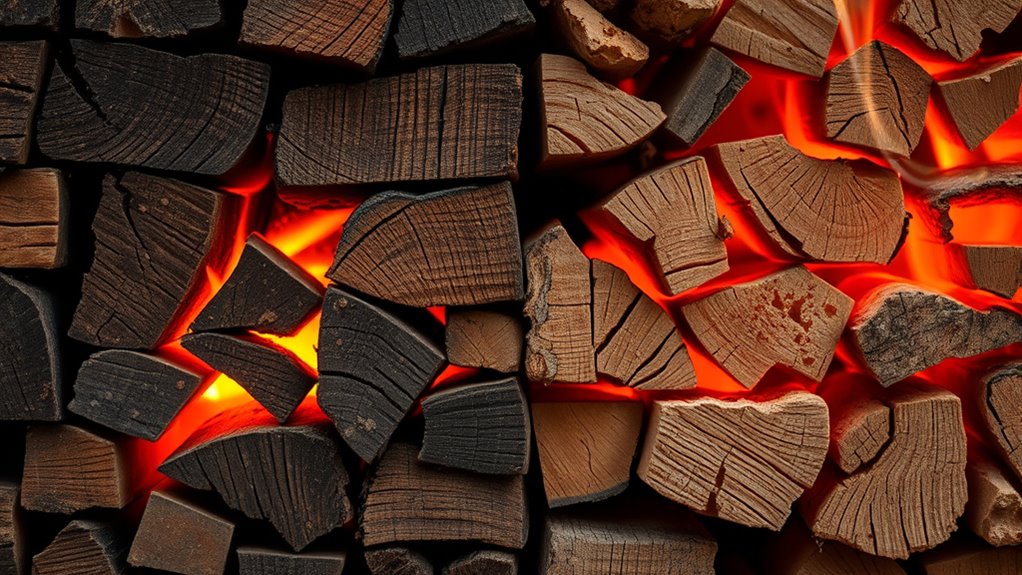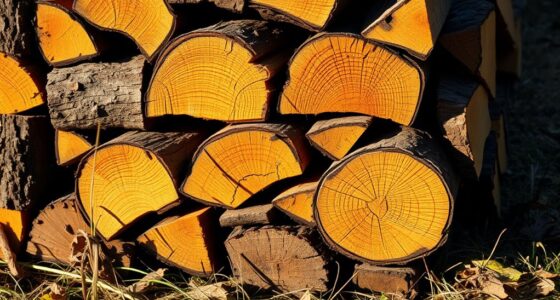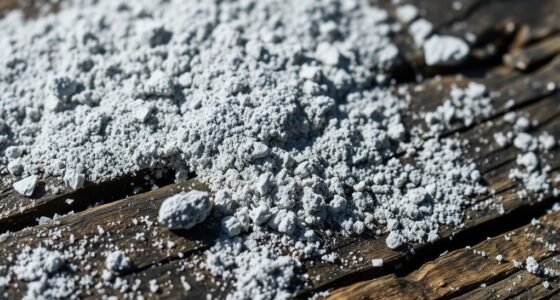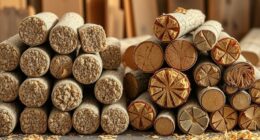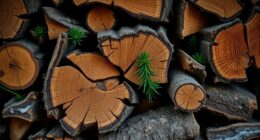Hardwoods generally produce more heat and burn longer than softwoods, making them better for sustained warmth and efficiency. They’re denser, so they hold fuel longer and give off a steady, higher heat output. Softwoods ignite faster and burn out quicker, perfect for quick fires or starting fires. If you want a longer-lasting, hotter fire, hardwoods are your best bet. To find out how to choose the right firewood for your needs, keep exploring the details below.
Key Takeaways
- Hardwoods generally produce higher heat output and longer burn times due to their density and lower moisture content.
- Softwoods ignite quickly and burn hotter initially but tend to burn out faster than hardwoods.
- Properly seasoned hardwoods burn more efficiently, providing steady, sustained heat over extended periods.
- Softwoods are suitable for quick heating or starting fires, but require more frequent reloading for continued warmth.
- Overall, hardwoods are more fuel-efficient for prolonged, consistent heating, while softwoods excel for short-term or quick fires.
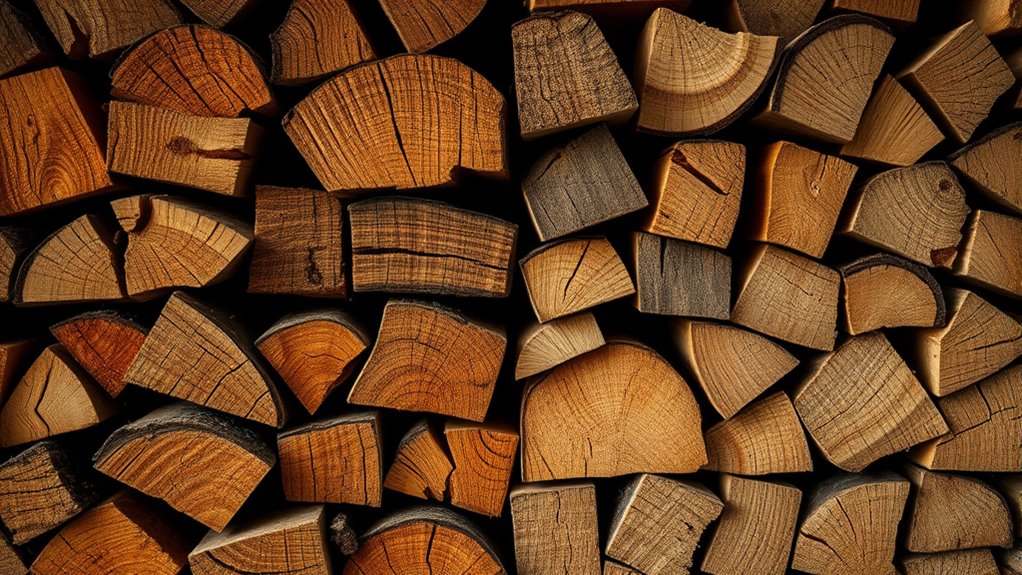
When choosing between hardwoods and softwoods for your project, understanding their fundamental differences can help you make an informed decision. One key factor to weigh is moisture content, as it directly impacts how efficiently the wood burns and how much heat it produces. Generally, hardwoods tend to have lower moisture content when properly seasoned, which means they burn more steadily and produce more heat over a longer period. Softwoods, on the other hand, often contain higher moisture levels, especially if not adequately dried, leading to more smoke and less heat output. Properly seasoned wood is crucial for optimal burn performance and efficiency. Additionally, the moisture content of wood plays a significant role in its burning characteristics and heat output. Understanding seasoning techniques can significantly improve your wood-burning experience. Ease of splitting is another important aspect, especially if you’re preparing firewood yourself. Hardwoods are typically denser and more challenging to split, requiring more effort and sometimes specialized tools. Softwoods are usually softer and easier to split, making the process quicker and less labor-intensive. This difference can influence your choice depending on how much time and effort you’re willing to invest in preparing your firewood. If you prefer quick and easy preparation, softwoods might be more appealing; if you’re willing to put in the effort for potentially longer-lasting, higher-heat fires, hardwoods could be the better option. The heat output of hardwoods versus softwoods also varies markedly. Hardwoods such as oak, hickory, and maple tend to produce a higher amount of heat per cord, thanks to their density and lower moisture content. They burn longer and more efficiently, making them ideal for sustained heating and longer-lasting fires. Softwoods like pine, spruce, and cedar ignite quickly and burn hotter initially, but they tend to burn out faster because of their lower density. This makes softwoods suitable for quick heating needs or starting fires, but they often require more frequent replenishing. Burn time is another vital consideration. Hardwood fires tend to last longer because of their density and slower combustion rate, providing consistent warmth over extended periods. Softwoods, while igniting rapidly and burning hotter initially, tend to burn out faster, which means you’ll need to reload your fire more often. If you’re looking for a long-lasting fire that provides steady heat, hardwoods are generally preferable. However, if you need a quick burst of heat and ease of use, softwoods can be convenient. To maximize efficiency, understanding the advantages of different wood types can help you select the best fuel for your specific needs.
Frequently Asked Questions
How Does Moisture Content Affect Hardwood and Softwood Burning?
Moisture content greatly impacts how efficiently you burn hardwoods and softwoods. When moisture levels are high, both types take longer to dry during the drying process, producing more smoke and less heat. To maximize heat output and burn time, guarantee your wood is properly seasoned, with low moisture levels. Proper drying reduces creosote buildup and enhances combustion, making your fire cleaner, hotter, and more efficient.
Which Type of Wood Produces More Creosote Buildup?
Imagine a chimney with dark streaks of creosote buildup, and you realize softwoods tend to produce more creosote accumulation. Softwoods burn quickly and generate more volatile gases, which cool and condense in the chimney, leading to more creosote. To keep your chimney safe and efficient, regular chimney cleaning is essential, especially if you burn softwoods frequently. This prevents dangerous creosote buildup and reduces fire risks.
Are There Environmental Benefits to Choosing Hardwood Over Softwood?
Yes, choosing hardwood can be environmentally beneficial. Hardwoods often come from sustainable reforestation practices, which help preserve ecosystems. They also support carbon sequestration, as mature hardwood trees absorb and store more carbon dioxide. By selecting hardwoods, you promote responsible forest management, reduce deforestation, and help mitigate climate change. Your choice encourages sustainable harvesting, ensuring forests remain healthy and continue providing ecological benefits for future generations.
How Does Wood Density Influence Heat Output Efficiency?
Did you know that denser woods can produce up to 25% more heat? Wood density comparison plays a vital role in energy efficiency, as higher density woods pack more energy per volume. When you choose dense hardwoods, you get longer burn times and better heat output. This means your stove runs more efficiently, conserving fuel and providing consistent warmth, making dense woods a smart choice for heating.
Can Softwoods Be Safely Used for Indoor Fireplaces?
Yes, you can safely use softwoods for indoor fireplaces if they’re properly dried and treated. Make sure the wood is well-seasoned to reduce creosote buildup, which can cause chimney fires. Avoid using wood with excessive bark or sap, as these can release harmful fumes. Always follow indoor safety guidelines and ensure good ventilation. Proper wood treatment minimizes risks, making softwoods a viable, efficient option for your fireplace.
Conclusion
When choosing between hardwoods and softwoods, remember that softer woods ignite quickly and burn fast, but don’t last long. Hardwoods, on the other hand, might take longer to light, but they offer a steadier, longer-lasting heat. So, if you want instant warmth, softwoods are your go-to. But for sustained heat and efficiency, hardwoods prove their worth. The choice depends on whether you prioritize quick flames or lasting comfort.

